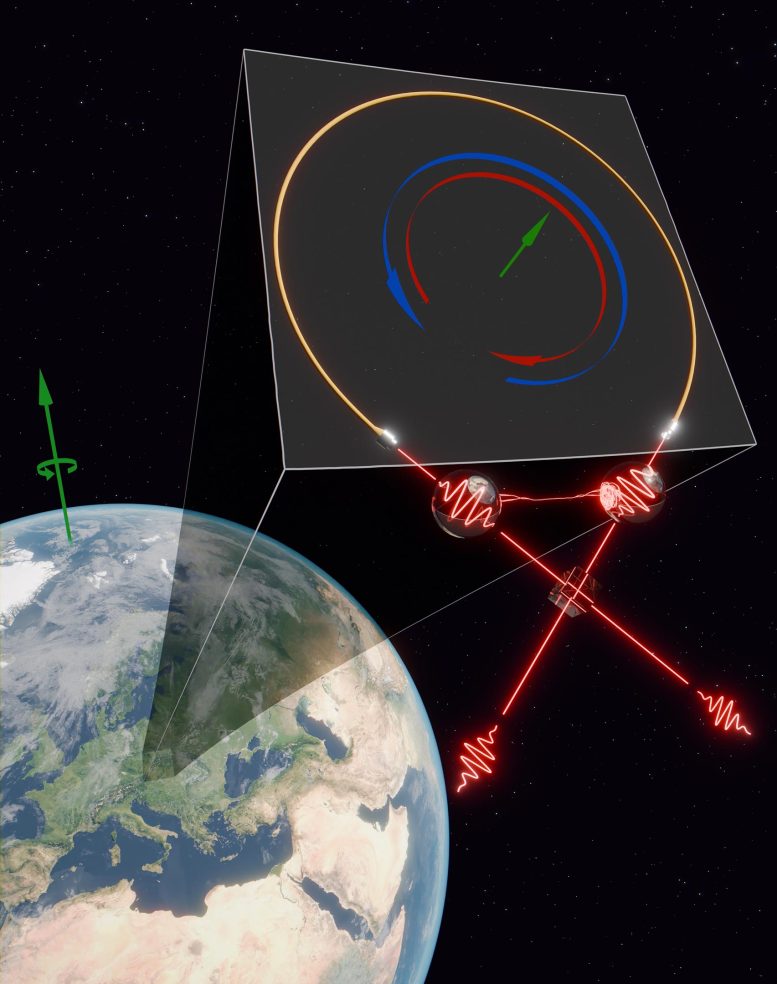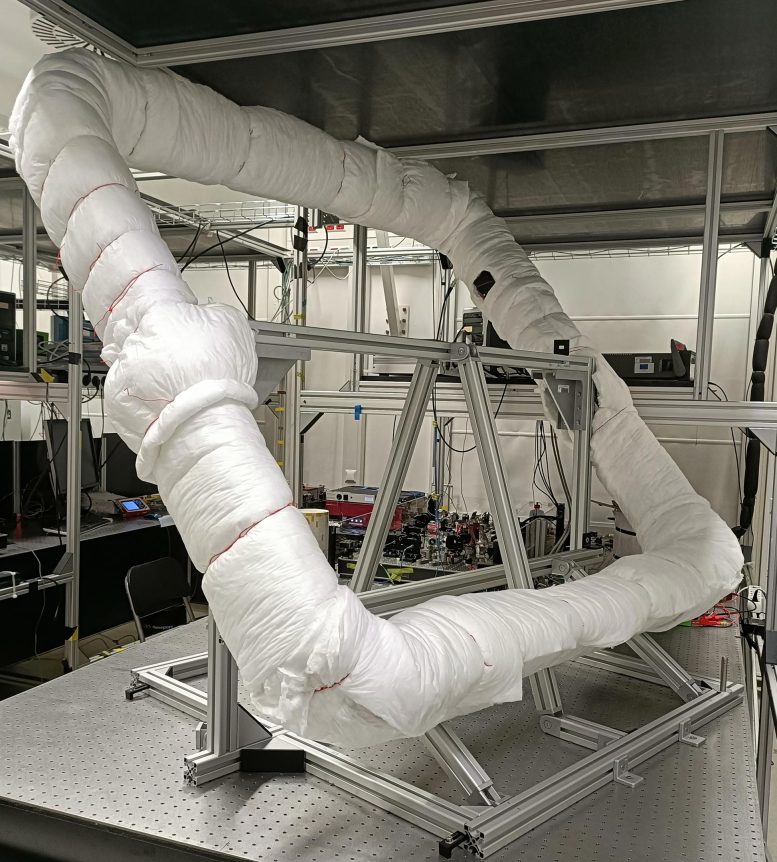Quantum Entanglement Measures Earth’s Rotation Like Never Before


The experiment was pictured drawing a fiber Sagnac interferometric scheme inside a magnifying inset starting from a local position (Vienna, Austria) of the rotating Earth. Two indistinguishable photons are incident on a beam splitter cube, entanglement between them is created, and then they are coupled in the fiber interferometer. Credit: Marco Di Vita
A quantum physics experiment at the University of Vienna achieved groundbreaking precision in measuring Earth’s rotation using entangled photons.
The study utilizes an enhanced optical Sagnac interferometer that leverages quantum entanglement to detect rotational effects with unprecedented precision, offering potential breakthroughs in both quantum mechanics and general relativity.
Pioneering Quantum Experiment
A team of researchers carried out a pioneering experiment where they measured the effect of the rotation of Earth on quantum entangled photons. The work, led by Philip Walther at the University of Vienna, was just published in the journal Science Advances. It represents a significant achievement that pushes the boundaries of rotation sensitivity in entanglement-based sensors, potentially setting the stage for further exploration at the intersection between quantum mechanics and general relativity.
Advances in Sagnac Interferometers
Optical Sagnac interferometers are the most sensitive devices to rotations. They have been pivotal in our understanding of fundamental physics since the early years of the last century, contributing to establishing Einstein’s special theory of relativity. Today, their unparalleled precision makes them the ultimate tool for measuring rotational speeds, limited only by the boundaries of classical physics.

Sagnac interferometer built with 2-kilometers of optical fibers wrapped around 1.4 meter sided square aluminum frame. Credit: Raffaele Silvestri
Quantum Entanglement Enhances Sensitivity
Interferometers employing quantum entanglement have the potential to break those bounds. If two or more particles are entangled, only the overall state is known, while the state of the individual particle remains undetermined until measurement. This can be used to obtain more information per measurement than would be possible without it. However, the promised quantum leap in sensitivity has been hindered by the extremely delicate nature of entanglement.
Here is where the Vienna experiment made the difference. They built a giant optical fiber Sagnac interferometer and kept the noise low and stable for several hours. This enabled the detection of enough high-quality entangled photon pairs such to outperform the rotation precision of previous quantum optical Sagnac interferometers by a thousand times.
Innovative Techniques in Quantum Measurement
In a Sagnac interferometer, two particles traveling in opposite directions of a rotating closed path reach the starting point at different times. With two entangled particles, it becomes spooky: they behave like a single particle testing both directions simultaneously while accumulating twice the time delay compared to the scenario where no entanglement is present. This unique property is known as super-resolution. In the actual experiment, two entangled photons were propagating inside a 2-kilometer-long optical fiber wounded onto a huge coil, realizing an interferometer with an effective area of more than 700 square meters.
Overcoming Challenges in Quantum Experiments
A significant hurdle the researchers faced was isolating and extracting Earth’s steady rotation signal. “The core of the matter,” explains lead author Raffaele Silvestri, “lays in establishing a reference point for our measurement, where light remains unaffected by Earth’s rotational effect. Given our inability to halt Earth’s spinning, we devised a workaround: splitting the optical fiber into two equal-length coils and connecting them via an optical switch.”
By toggling the switch on and off the researchers could effectively cancel the rotation signal at will, which also allowed them to extend the stability of their large apparatus. “We have basically tricked the light into thinking it’s in a non-rotating universe,” says Silvestri.
Confirming Quantum Mechanics and Relativity Interactions
The experiment, which was conducted as part of the research network TURIS hosted by the University of Vienna and the Austrian Academy of Sciences, has successfully observed the effect of the rotation of Earth on a maximally entangled two-photon state. This confirms the interaction between rotating reference systems and quantum entanglement, as described in Einstein’s special theory of relativity and quantum mechanics, with a thousand-fold precision improvement compared to previous experiments.
“That represents a significant milestone since, a century after the first observation of Earth’s rotation with light, the entanglement of individual quanta of light has finally entered the same sensitivity regimes,” says Haocun Yu, who worked on this experiment as a Marie-Curie Postdoctoral Fellow.
“I believe our result and methodology will set the ground to further improvements in the rotation sensitivity of entanglement-based sensors. This could open the way for future experiments testing the behavior of quantum entanglement through the curves of spacetime,” adds Philip Walther.
Reference: “Experimental observation of Earth’s rotation with quantum entanglement” by Raffaele Silvestri, Haocun Yu, Teodor Strömberg, Christopher Hilweg, Robert W. Peterson and Philip Walther, 14 June 2024, Science Advances.
DOI: 10.1126/sciadv.ado0215